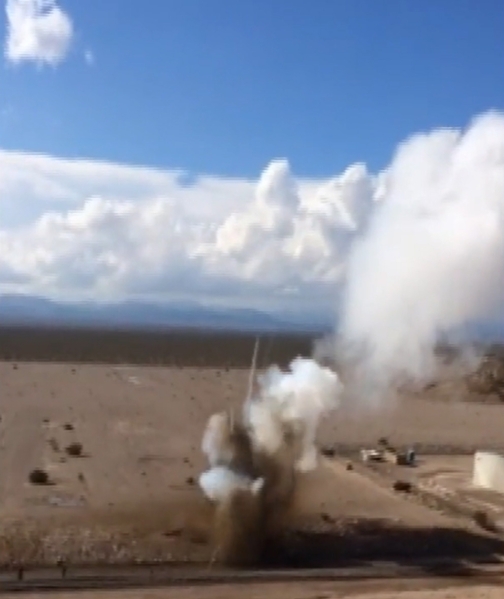Video near Beatty shows blast a radioactive waste site
A video of Sunday's explosions that preceded a fire in a state-owned radioactive waste trench at the US Ecology site 10 miles south of Beatty shows white smoke emanating from the soil before the ground erupts, shooting debris and more white smoke into the air.
The 40-second cellphone video, released Oct. 22 by the Nevada Department of Public Safety two days after the Las Vegas Review-Journal had requested it, was taken from a berm atop Trench No. 11 overlooking the soil cap of Trench No. 14.
Trench No. 14 is where containers of low-level radioactive waste were buried in part of a pit the size of a football stadium in the 1970s.
Authorities shut down a 140-mile stretch of U.S. Highway 95 for nearly 24 hours because of the fire and flash floods during Sunday's heavy rains in Nye County. Beatty is about 117 miles northwest of Las Vegas.
State Fire Marshal Chief Peter Mulvihill said Oct. 20 investigators don't know yet what caused the "energetic burning" in that pit Sunday but whatever caught fire below the surface of the unlined, clay terrain "definitely burned very hot."
The state's public safety team decided to allow the fire to burn itself out instead of trying to douse it because they didn't want to put water on any material that might be reactive to water, fearing that could potentially exacerbate the problem.
Preliminary results from aerial surveys conducted Monday by a Department of Energy fixed-wing aircraft and a helicopter equipped with gamma ray detection sensors were negative as was monitoring by four Nevada National Guard soldiers. Wearing protective gear, they walked within 6 feet of the burn center to detect if any heavier radioactive beta or alpha particles were carried by the smoke plume and fell to the ground.
The state's probe will consider if the fire was related to the wet weather, and if disposal records kept by the state in Carson City and at the site list any materials that could have reacted with water to cause the fire.
For 30 years — from 1962 through 1992 — the dump operated by US Ecology and its predecessor, Nuclear Engineering Co., on state land leased to the companies was one of a few graveyards in the United States for disposing low-level nuclear waste along with sites in Barnwell, S.C., and Richland, Wash.
The Beatty dump, as it is sometimes called, occupies a stark, treeless stretch in the Amargosa Desert. It looks harmless from US. 95 with the appropriately named Bare Mountains off in the distance.
US Ecology continues to operate a 40-acre landfill for hazardous waste adjacent to the 40-acre landfill for low-level radioactive waste that closed Jan. 1, 1993. That's when US Ecology was forced to shut its gates to nuclear waste haulers because of a federal law that required individual states to open their own dumps or join compacts with other states for regional disposal of low-level radioactive waste.
Items buried in the low-level nuclear waste dump include contaminated laboratory gear, medical isotopes and nuclear reactor crud but not highly radioactive used-nuclear-fuel assemblies, the type of high-level waste the government has planned to entomb in Yucca Mountain, 100 miles northwest of Las Vegas.
Materials in the hazardous waste disposal area include chemicals and electrical transformers tainted with cancer-causing PCBs — polychlorinated biphenyls.
The Beatty site was licensed by the federal Nuclear Regulatory Commission until 1997 when authority was transferred to Nevada after the low-level radioactive waste portion of the site was closed.
Contact Keith Rogers at krogers@reviewjournal.com. Find him on Twitter: @KeithRogers2

















